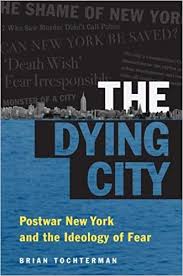Keep Trying To Make Sense – Gotham Version
New York City, Gotham, a space of opportunity or threat? Or perhaps both?
Brian Tochterman is an associate professor of sustainable community development at Northland College and the author of The Dying City: Postwar New York and the Ideology of Fear. The book is a reworking of his University of Minnesota history dissertation, but it’s not traditional history. This is cultural and intellectual history, with little economics, demographics, political studies – and few “great men.” Tochterman, who is from the midwest, has a provocative perspective on New York City in the latter part of the twentieth century.

The Dying City spans from the end of World War II until the early 1980s. Tochterman posits two discourses about the city: cosmopolis, as exemplified by the optimism of a young E.B. White, and necropolis, as defined by Mickey Spillane. These visions and narratives competed as ways to best understand and define a rapidly changing New York City. White presented the city as open, young, growing and inclusive; Spillane represented the city as dangerous, a frontier with little order calling out for violence and strong men. From these two constructs, Tochterman spins a web of voices, actions, debates and decisions to explain the Big Apple.
The book draws from literature, film, popular culture, criticism, music and media. It’s not comprehensive. Instead, Tochterman’s methodology is more opportunitistic and impressionistic. He crafts arguments of contrast: White and Spillane, Robert Moses and Jane Jacobs, growth versus destruction. Running throughout the narrative is a heightened appreciation of how narratives of fear framed debates, decisions and cultural production. The books makes one appreciate just how pervasive fear is as a justification, a motivator, and as a means of control.
One of the challenges of cultural history is inclusivity. Most people do not get published, do not produce “culture” and their voices and influence may not be recognized. I think that the issue especially difficult in framing what happens in the city, where interactions between people and groups of people spark all manner of creativity. New York City has been a tremendous engine for cultural production. Tochterman’s construct tends to focus on the work made by white and educated professionals. There’s nothing wrong with that focus, but is it the most representative? He could have done something similar but given priority to the origin and growth of hip hop and rap, for example. Who matters more: E. B. White or Grandmaster Flash? There are no easy answers – just different framings.
One could claim, using a more traditional history lens, that there are more “accurate” ways of understanding the sweeping changes New York City faced after World War II. One could pay close attention to demographics, to changes in the economy, to broad political trends, and the general shift of influence to the west and the south. However, that is a different kind of book. Tochterman has crafted something thoughtful in The Dying City. It’s creative and well done. And while it may be a bit too dissertation-like for some, I found it very interesting.
David Potash